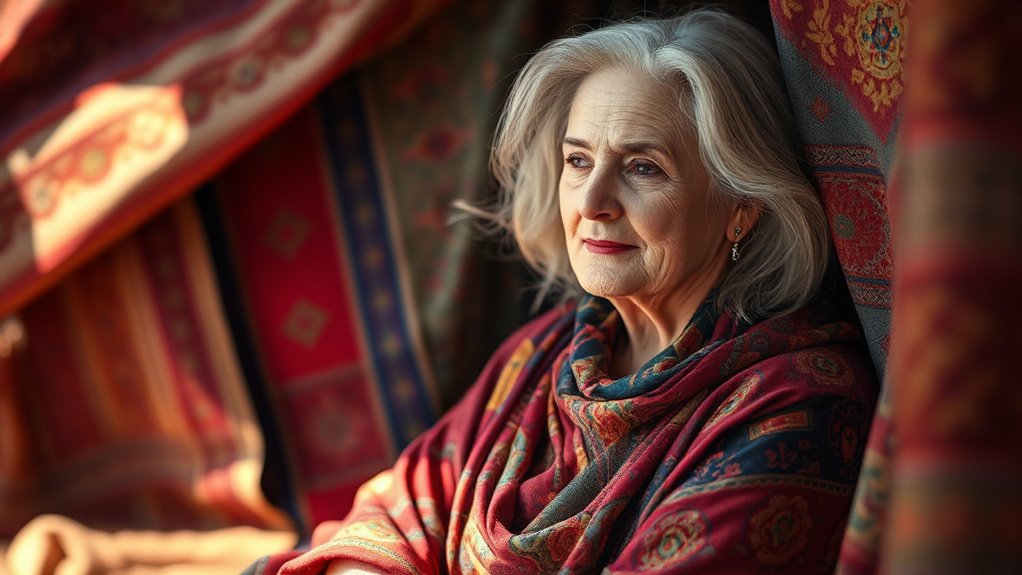Etel Adnan was a Lebanese-American poet and artist renowned for blending multilingual poetry, abstract paintings, and cross-cultural influences. Growing up speaking Greek, Turkish, Arabic, and French, she deeply connected with diverse traditions, shaping her work’s themes of exile, identity, and beauty. Her poetic voice, enriched by philosophy, evolved into vibrant visual art, multimedia, and installations. To uncover how her unique background and activism influenced her creations, explore more about her inspiring life and work.
Key Takeaways
- Etel Adnan (1925–2023) was a Lebanese-American poet and visual artist renowned for her poetic collections and abstract paintings.
- She grew up multilingual in Beirut, influenced by Middle Eastern, European, and Mediterranean cultures, shaping her artistic voice.
- Adnan studied philosophy at the Sorbonne, Berkeley, and Harvard, integrating philosophical ideas into her literary and visual work.
- Her poetry explores themes of exile, identity, and social injustice, often blending surrealist imagery with formal experimentation.
- She created diverse artworks, including paintings, leporello books, and tapestries, emphasizing cosmic and spiritual motifs.
Early Life and Multilingual Roots

Etel Adnan’s early life was shaped by a rich tapestry of cultural and linguistic influences. Born in 1925 in Beirut, Lebanon, you grew up amid a diverse family background—your father, a Muslim-Turkish Ottoman officer from Damascus, and your mother, a Greek Orthodox from Smyrna. Your paternal grandmother was Albanian, adding another layer of ethnicity. At home, you spoke Greek with your mother and Turkish with your father, immersing yourself in multiple languages from an early age. Growing up in a chiefly Arabic-speaking society, you also learned French through Catholic convent schools and later mastered English. These multilingual roots and cultural surroundings deeply influenced your worldview, fueling your poetic and artistic expression with a unique blend of Middle Eastern, European, and Mediterranean traditions. Your multilingual upbringing allowed you to access and interpret diverse literary and artistic traditions, enriching your creative voice.
Academic Journey and Philosophical Foundations
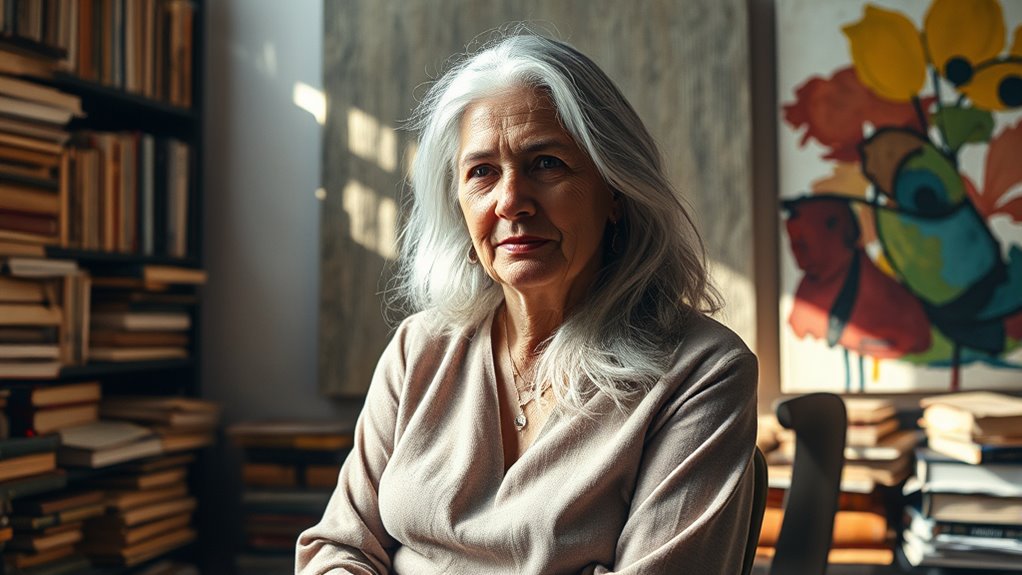
Your exploration of Etel Adnan’s academic journey reveals a rich multilingual background shaped by her studies in Lebanon, France, and the United States. Her philosophy education at institutions like the Sorbonne, Berkeley, and Harvard deeply influenced her artistic and poetic outlook. These diverse influences created a foundation where philosophy and language intertwined, shaping her creative and intellectual pursuits. Her extensive academic background also provided her with a unique perspective that informed her engagement with intercultural themes throughout her work. Additionally, her familiarity with projector technology concepts such as color accuracy and contrast ratio can be seen as parallel to her nuanced understanding of visual and conceptual harmony in art.
Multilingual Educational Background
How did a Lebanese-born poet and artist develop such a rich multilingual and philosophical foundation? It started with your early education in French Lebanese Catholic schools, where you learned French, Greek from your mother, and Arabic from your father. Studying French literature in school deepened your bilingual literary skills. Attending the Ecole Supérieure de Lettres de Beyrouth, you began composing poetry, immersed in Lebanon’s multilingual culture blending French colonial influence with Arab roots. Moving to Paris for philosophy studies at the Sorbonne, you gained critical thinking and aesthetic insights rooted in European traditions. Later, postgraduate studies in the U.S. expanded your perspectives, exposing you to American intellectual debates and politics. Teaching in California further strengthened your multilingual fluency and cross-cultural understanding, shaping your unique artistic voice. This diverse educational background also provided a foundation for your later work as a writer, painter, and designer, allowing you to navigate and synthesize multiple cultural and philosophical influences. Additionally, your exposure to multilingual education helped you develop a nuanced approach to language and expression that permeates your artistic endeavors.
Influences of Philosophy Studies
The foundation of your multilingual and cultural background was considerably shaped by your rigorous philosophy studies at prestigious institutions. Studying at the Sorbonne in Paris gave you essential academic grounding, while postgraduate work at UC Berkeley expanded your understanding of American intellectual traditions. Completing your philosophy degree at Harvard diversified your perspectives further. Teaching philosophy of art at Dominican University from 1958 to 1972, you engaged students with existentialist ideas influenced by Sartre and others, which deeply affected your creative work. Your philosophical education sharpened your analytical skills, fostering complex narratives in poetry and prose. It also inspired your visual art, especially abstract paintings, as alternative expressions during politically turbulent times like the Algerian war, shaping your resistance and cultural critique. Her studies in philosophy, particularly her engagement with existentialist thought, provided a framework for understanding human existence and the power of individual agency, which permeated her artistic and literary endeavors. Additionally, her exposure to philosophical traditions broadened her capacity for critical reflection across multiple disciplines.
Teaching Career and Cultural Engagement in California
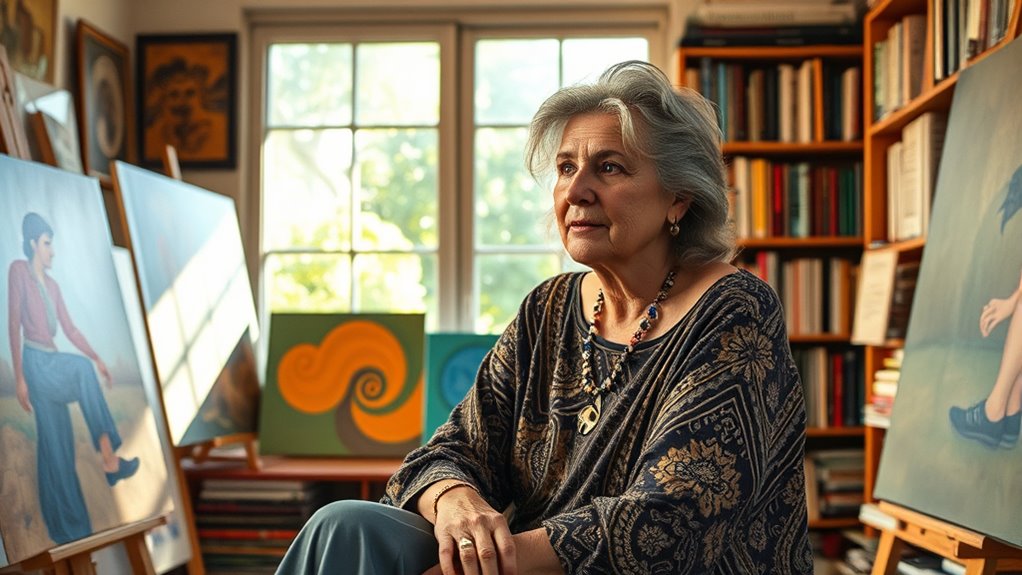
As you explore Etel Adnan’s time in California, consider how her teaching at Dominican College shaped her progression from theory to practical art, influenced by her multicultural background. You’ll see how she engaged with the local art scene in Marin County, blending her Lebanese heritage with Californian vibrancy. Her efforts in fostering cultural dialogue and activism made her a key figure in shaping Arab-American artistic presence in the region. During her tenure there, she also developed a deeper understanding of American art institutions, which further informed her innovative approach to combining language and visual art. Additionally, her exposure to artistic techniques and styles prevalent in the region enriched her creative repertoire.
Teaching at Dominican College
During her tenure at Dominican College from 1958 to 1972, Etel Adnan immersed herself in teaching the philosophy of art and aesthetics, shaping a unique approach that intertwined intellectual inquiry with cultural awareness. She declined a French teaching role to avoid marginalization and instead taught philosophy courses in English, engaging with contemporary political issues like the Vietnam War and Algerian independence. Her multicultural background and multilingual skills enriched her teaching, blending Mediterranean and Middle Eastern influences with Western philosophy. During this period, she began painting in her mid-thirties, encouraged by her colleagues, creating works that reflected her philosophical ideas through spontaneous gestures and bold oil strokes. Her classroom became a space for critical discussion on aesthetics, politics, and cultural identity, leaving a lasting impact on her students and academic community. Furthermore, her exposure to diverse cultures and philosophies fostered a multicultural perspective that deeply informed her artistic and teaching practices.
Cultural Editing in Beirut
Have you ever wondered how an artist’s diverse background influences their role as a cultural editor? In Beirut, Adnan returned to share her insights, working as a journalist and shaping the cultural landscape. She contributed to *Al Safa*, a French-language newspaper, where she helped build the cultural section and penned front-page editorials on political issues. Her multilingual skills—Greek, Turkish, French, English, and Arabic—enabled her to connect with various audiences. She also added cartoons and illustrations, blending her artistic talents with journalism. Her cultural editing reflected her rich heritage and international education, fostering a dialogue between different identities. Here’s a visual overview of her contributions:
| Role | Activities | Impact |
|---|---|---|
| Cultural Editor | Built cultural section | Promoted diverse voices |
| Journalism | Wrote editorials | Influenced political discourse |
| Artistic Contributions | Cartoons and illustrations | Enriched cultural narratives |
| Multilingual Skills | Communication across cultures | Bridged divides |
| Cultural Engagement | Promoting arts and culture | Strengthened Beirut’s scene |
Her ability to navigate multicultural environments further exemplifies how her linguistic and artistic skills enhanced her impact on Beirut’s cultural scene.
Literary Achievements and Notable Poetry Collections

Etel Adnan’s literary achievements are marked by a remarkable body of poetry collections that have garnered international recognition. You’ll notice her work spans decades, with titles like *Night* (2016), *Seasons* (2008), and *Time* (2019), the latter winning the Griffin Poetry Prize. Her earlier works, such as *Moonshots* (1966) and *The Indian Never Had a Horse* (1985), set foundational themes. Her poetry, published in both English and French, includes collections like *Nuit* and *Mer et brouillard*. You’ll find her style combines surrealist imagery, formal experimentation, and social themes, often exploring exile, identity, and injustice. Her poetic voice crosses cultural boundaries, blending Arab, French, and American influences, earning her prestigious awards and global acclaim.
Political Influences on Literary and Artistic Expression

Political conflicts and upheavals profoundly shaped Etel Adnan’s creative work, fueling both her literary and artistic expressions. You see her writing emerge as a form of resistance, especially against the Vietnam War, shifting from French to English to reach broader audiences. Her novel *Sitt Marie Rose* vividly portrays sectarian violence and civil war atrocities in Lebanon, reflecting her deep engagement with political oppression. Exile and displacement from Lebanon’s civil war influenced themes of loss and identity in her work. Throughout her career, she used poetry and art to address violence and conflict, promoting nonviolent resistance inspired by Tolstoy and Gandhi. Her visual art, often symbolic, incorporated landscapes that reflected political tensions, blending memory, resistance, and cultural narratives to challenge cycles of oppression. Her activism and philosophical outlook also reinforced her dedication to using art and literature as tools for social change and dialogue. Recognizing the importance of AI security, she believed that safeguarding cultural expressions was essential in times of political turmoil.
Transition From Words to Visual Art Forms
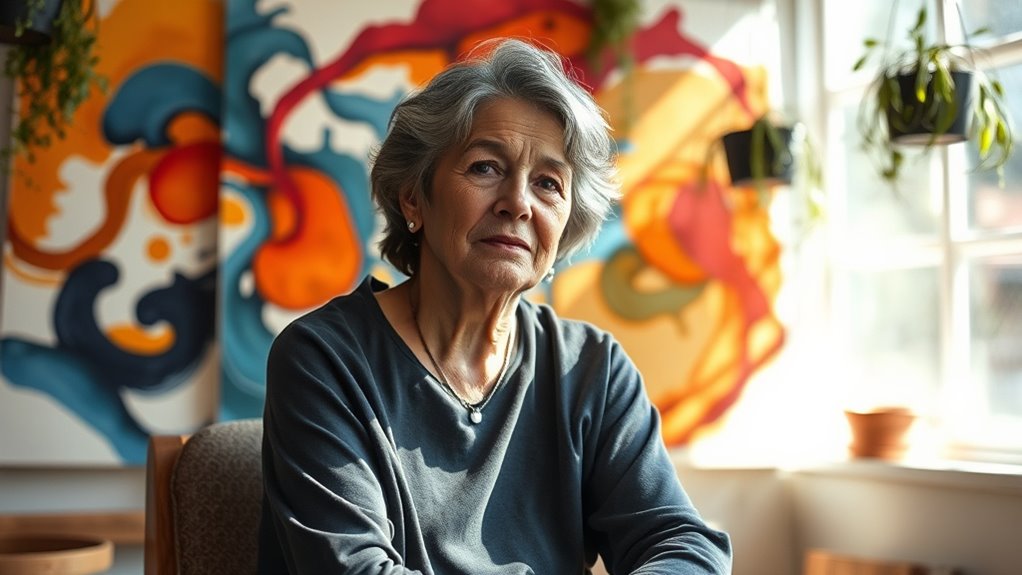
Around the age of 34, she made a pivotal shift from writing poetry and prose to exploring visual arts, driven by a desire to “paint in Arabic” and reconnect with her cultural roots. You see her materials as active participants, shaping meaning beyond passive supports. Her early works reflect memories, landscapes, and feelings of displacement from Lebanon, offering an alternative to her literary voice. Studied Arabic calligraphy and Hurufiyya movement to embed linguistic elements. Used leporello artist books blending text and images, intertwining poetry with visuals. Developed a pictorial language transforming words into shapes and colors. Visual art became a way to reclaim her relationship with language, memory, and identity. Her shift expanded her creative palette, blending cultural symbols with personal narratives. This transition was influenced by her interest in integrating traditional Arab artistic practices, emphasizing the importance of language and symbolism in her multidisciplinary approach. Additionally, her exploration of cultural symbolism enriched her visual vocabulary, allowing her to communicate complex themes beyond words.
Artistic Style, Media, and Exhibitions
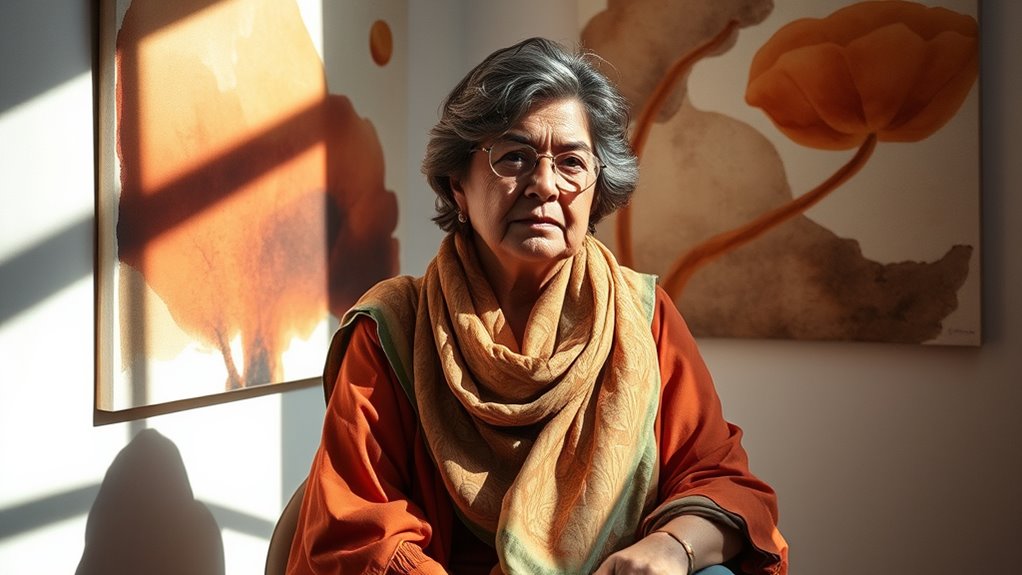
After shifting from literary to visual expression, her artistic style develops into a distinctive language rooted in abstraction. You notice her use of geometric shapes—squares, circles, and lines—that evoke emotional landscapes and cosmic memory. She applies color directly from the tube, emphasizing purity and immediacy, often creating flat swathes of pigment that resemble signs rather than literal images. Her landscapes lack human figures, focusing instead on universal beauty and cosmic bonds, with confident brush strokes and interlocking color blocks. Working across media—painting, tapestry, film, ceramics, leporello books—she treats materials as co-authors. Her exhibitions, including Documenta 13 and shows at the Guggenheim, highlight her influence as a pioneering Arab-American artist. Additionally, her work reflects a cultural significance of seeds, emphasizing themes of growth and interconnectedness.
Themes of Exile, Identity, and Cross-Cultural Experience
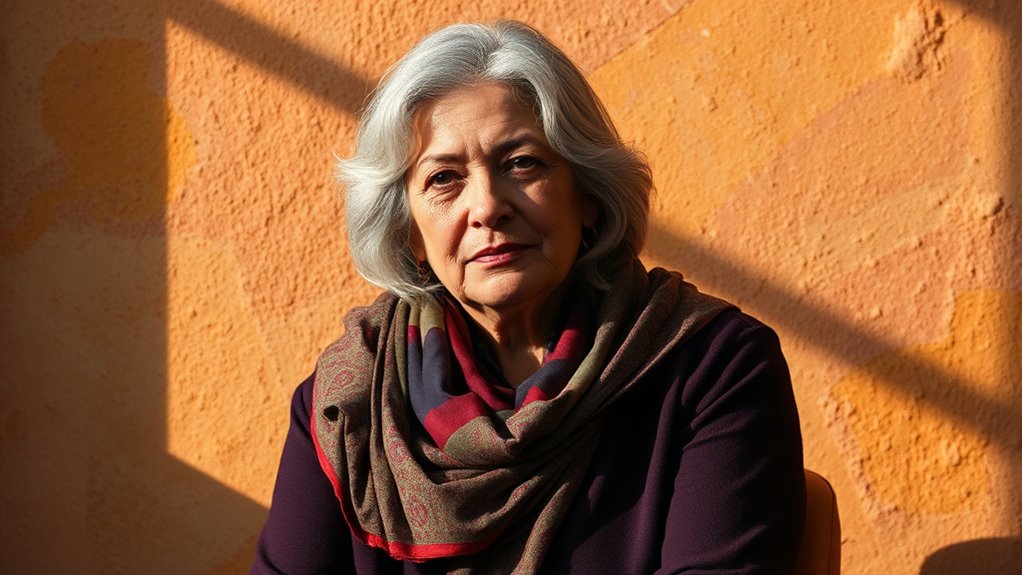
Etel Adnan’s work vividly explores the complex themes of exile, identity, and cross-cultural experience, revealing how displacement shapes her artistic and poetic voice. You see her grappling with exile’s emotional toll, using symbols like the sun and sea to represent longing and stability. Her poetry reflects a dialogue between her roots in Beirut and her life abroad, steering through a fluid sense of belonging. She challenges simple notions of identity, emphasizing shared histories and resistance, often through multilingual expression. Her work acts as a bridge between Arab and Western cultures, blending mythologies and philosophies. Themes of conflict and resilience run deep, with motifs of war and hope intertwining to depict both trauma and renewal.
- Symbolic natural imagery of sun and sea
- Negotiation of personal and collective identity
- Multilingual and bicultural expression
- Cultural bridges between East and West
- Reflection of conflict, resistance, and hope
Honors, Legacy, and Impact on Art and Literature

How has Etel Adnan’s work left a lasting mark on both literature and the arts? Her numerous honors, like the France-Pays Arabes Award and the Griffin Poetry Prize, recognize her influence across genres. The establishment of the Etel Adnan Poetry Prize and Series continues her legacy, supporting emerging Arab American poets and promoting diverse voices. Her interdisciplinary practice—combining poetry, painting, and sculpture—has expanded artistic boundaries, blending visual art with literary themes of identity and exile. Exhibitions, including the Whitney Biennial, showcase her innovative approach. Her work’s political and cultural impact, especially through *Sitt Marie Rose*, remains profound. The series supports writers of Arab heritage. Adnan’s legacy endures in both awards and institutions, inspiring new generations to explore art’s power to challenge, unite, and transform.
Frequently Asked Questions
What Inspired Etel Adnan’s Shift From Poetry to Abstract Painting?
You’re curious about what inspired her shift from poetry to abstract painting. She was influenced by her time in California around 1960, seeking new ways to express responses to violence and war. Painting offered a nonverbal, spiritual outlet emphasizing color, harmony, and balance. Her interest in abstract art, combined with Sufi philosophy and personal memories of landscapes, drove her to explore emotional and universal themes through visual, intuitive forms.
How Did Her Multicultural Background Influence Her Artistic Themes?
Your multicultural background acts as a prism, refracting your artistic themes into vibrant, layered landscapes. Growing up amid diverse languages, religions, and histories, you navigate themes of exile, displacement, and identity. This rich tapestry fuels your work’s emotional depth, blending Eastern calligraphy with Western modernism. Your art becomes a dialogue across cultures, capturing the complexities of belonging and fragmentation, allowing universal stories rooted in personal history to resonate deeply with all who experience it.
In What Ways Did Political Events Shape Her Creative Expressions?
Political events profoundly shape your creative expressions by pushing you to explore themes of conflict, exile, and resistance. When you witness war and colonial struggles, you channel those experiences into poetry and art that challenge dominant narratives. Your work balances violence and nature, reflecting societal scars and personal loss. Through activism and multilingualism, you use your creativity to protest oppression, preserve cultural identity, and find resilience amid turmoil.
What Are the Unique Features of Her Visual Art Style?
Imagine a vibrant tapestry woven with bold colors and thick textures that speak directly to your emotions. You notice geometric shapes, like sturdy bricks building a contemplative space, while poetic symbols whisper hidden meanings. Her abstract landscapes evoke calmness and spiritual reflection, blending color and form effortlessly. You experience a visual language that’s open-ended, inviting personal interpretation—her unique style transforms simple strokes into a poetic dialogue between color, shape, and soul.
How Has Her Work Impacted Contemporary Arab-American Literature and Art?
Your work has profoundly shaped contemporary Arab-American literature and art by bridging cultural divides and inspiring new generations. You explore themes of identity, belonging, and the impact of war, offering a unique perspective that resonates universally. Through your innovative use of language, art, and storytelling, you challenge traditional boundaries, encouraging others to embrace their heritage while fostering dialogue between Arab and American cultures. Your influence continues to inspire creative exploration and cultural understanding.
Conclusion
Your journey through etel adnan’s life reveals how she transforms exile and identity into powerful art and poetry. Her multilingual roots and cross-cultural experiences shape her unique voice, inspiring countless others. As you reflect on her legacy, ask yourself: isn’t it through embracing our diverse stories that we truly find our voice and create lasting impact? Adnan’s work reminds us that art and words are bridges connecting worlds, identities, and histories.

